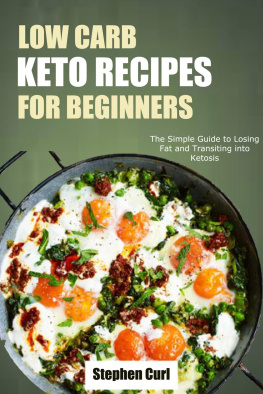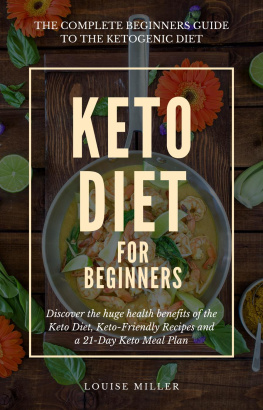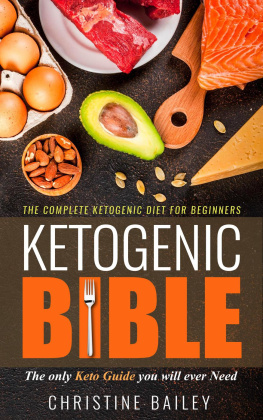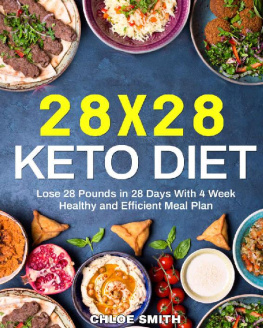Table of Contents
Keto Diet: A Comprehensive Ketogenic Diet Guide for Beginners
(3rd Edition)
Walter. A. Jennings 2018
All Rights Reserved
The facts herein provided is truthful in all its entirety and coherent, in that no legal responsibility, in the form of consideration or else by the use or misuse of any strategies, procedures or directions contained within shall lie against the author such liability thereon is the sole and the utter obligation of the reader solely. Under no situation will any legal duty or responsibility shall be imputed or held out unfavorable the publisher(s) for any form of compensation, damages, pecuniary loss due to the information contained herein be it direct or indirect.
The information offered here is for the purposes of information only and is universal as such. The information presented here is without any form of contract or guarantee or indemnity whether with the reader or any third party.
CHAPTER ONE
What is the Ketogenic Diet
The Ketogenic, keto for short is a high fat and low-carb diet that encourages weight loss, as well as derive other essential benefits. When you eat a high-carb diet, your body burns glucose for energy because the carbohydrates are converted into glucose.
The problem with glucose, however, is that your body can only store a limited amount of glucose per time within your muscle cells. Then it triggers the release of insulin to take care of the remaining glucose that cannot be stored at the moment.
To lure your body to burn carb instead of fat, the first thing that you must do is to lower the intake of carbohydrate and increase the consumption of fat. This switch in the use of energy is what is often referred to as Ketosis. This results in a build-up of acids known as ketones within the body. When there is a strong presence of ketones in your body, it means you are in a state of ketosis and in that state, your body burns fat for energy, and you are able to burn off all the stored up excess fats within your body.
What to know
Under normal circumstances, the human body thrives on carbohydrates, protein, and fat. When the carbohydrate reservoir are used up in the body, the human body looks for alternative source of energy. The need for this becomes even more apparent when carbs are eliminated from food that is consumed. Among the fuels that the body needs are free fatty acids, which many cells in the body can use. Some cells in the body cannot, however, use Free Fatty Acid. The brain cannot use it. They can make use of ketone bodies. When this free fatty acid is not completely broken down in the liver, ketone bodies are produced. This fatty acid that has not been broken down will serve as a source of fuel for the brain.
Differences between Keto diet and other Low Carb diets
That a person lowers the intake of carbohydrate does not mean that he is undertaking the keto diet. The keto diet is weigh beyond reducing the quantity of carbs that is taken.
First, the composition of the keto diet is different from other types of low carb diet. This is perhaps is the greatest distinguishable factor between the Keto diet and other diets that are low in carbs. While the Keto diet is majorly a low-carb and high-fat diet, in the case of other forms of diets that are low in carb, it could be low carb and high protein. It is important to know that your fat level in a low carb diet does not matter since the body runs on carbohydrate as its key fuel source. On the other hand, on a Keto diet, about 70 percent of your calories per day are from fat, since fat has now become your primary source of fuel.
Secondly, the percent of carb intake is another great area of difference between low carb and keto diet. This is another form of the difference between Keto diet and other forms of low carb diet. Many types of research have suggested that eating less than 30% of calories gotten from carbohydrate. That is 50 to about 125 grams of carbs daily. On the other hand, on a Keto diet, the intake of carbohydrate is about 5 to 15% per day and a maximum threshold of 50 grams of carbs.
Thirdly, the rate of weight Loss is another distinguishing factor. It will be important for you to know that the weight lost on the Ketogenic diet is faster than those experienced in other low carb diets. This is no conjecture or manufacture of facts. In our first difference that was explained above, we have stated that in Ketogenic diet, your intake of carbohydrate is lower than it can be in other forms of low carb diets. While in other diets, your carb can be up to 30%, but in Ketogenic diet, the carb intake can be just 10%. Now looking at the above, who will lose weight faster? Certainly, the person who is on a Ketogenic diet.
Fourth, energy source differentiates both diets. The source of fuel in the body when a person is on a low carb diet is carbohydrate while in the case of Ketogenic diet, the main source of fuel comes from ketone bodies which are mostly fat.
Starting the Keto Diet Lifestyle
Start your changes small. Drop one bad eating habit at a time until you have achieved your goal of doing the diet entirely. Do not make your adjustment too sudden. Take your diet; begin by dropping the negative habits of eating food that are not keto-complaint little by little. If the habit took long to form, it would take time for you to stop it. Some dieticians have recommended that in starting the keto diet, you do the following:
- Clear your pantry
- Restock your fridge
If you clear your pantry immediately, restocked your fridge then the sudden changes may be too much for you to bear. But begin migration to the keto diet gradually. This makes it easier for your body to acclimatize to the change in energy source.
The goal of this diet is not for you to lose weight alone, get thin, and look smaller. It is also based on healthy eating lifestyle.
CHAPTER TWO
Who can do the Keto Diet?
Everybody can go on the keto diet and lose weight rapidly. However, there are restrictions. The fundamental question is, can Keto diet be undertaken by everybody? Are there people who are supposed to go on a Keto diet or are there people who should not go on a Keto diet?
Expectant and Breastfeeding Mom
A pregnant woman can go on a Ketogenic diet, but it must be carefully done with the guidance of a physician or dietitians. There is a risk for a pregnant woman. Serious weight loss at the time of pregnancy may affect the fetus or the baby because of the release of toxins. Weight loss during pregnancy and breastfeeding may have negative consequences for the baby or fetus as a result of the production of toxins by the fat cells. However, there is much research that encourages pregnant and breastfeeding moms to go on a Ketogenic diet.
Type 1 Diabetes
In the case of type 1 diabetes, the bodys defense system which can also be called the immune system assails a part of the bodys pancreas. The reason why this happens is not known. The bodys immune system erroneously destroys the cells in the pancreas because it sees them as foreign. These cells which are destroyed by the immune system are known as islets, and they are the ones that are responsible for dictating the levels of glucose in the blood stream, and when they see that the level of glucose is high, they produce the amount of insulin required to bring blood sugar to normal levels. Without insulin, blood sugar can be really high, and a lot of devastating consequences can occur. I needed to explain this. Now, this is the catch when you are on a Ketogenic diet; there is a switch in the fuel source. Your body switches from burning carbs stored as glucose to fats. Since the intake of carb is limited, fat is used as a fuel source. Remember that at this stage your body is no longer taking in glucose. It will begin to break down the fat in the muscles and other parts of the body system. This happens when you are on a Ketogenic diet, and you have entered ketosis; what you use as energy is fat and it is the breakdown of this fat that results in the buildup of ketone bodies. Ketone bodies enter the blood stream, and a chemical imbalance occurs which is known as diabetic ketoacidosis. To engage in the Ketogenic diet without the direction of a physician is dangerous for Type 1 diabetes.












